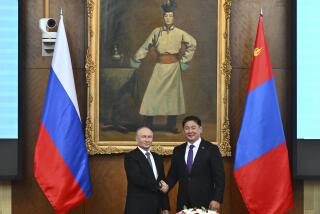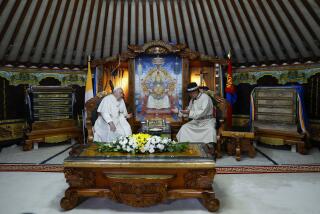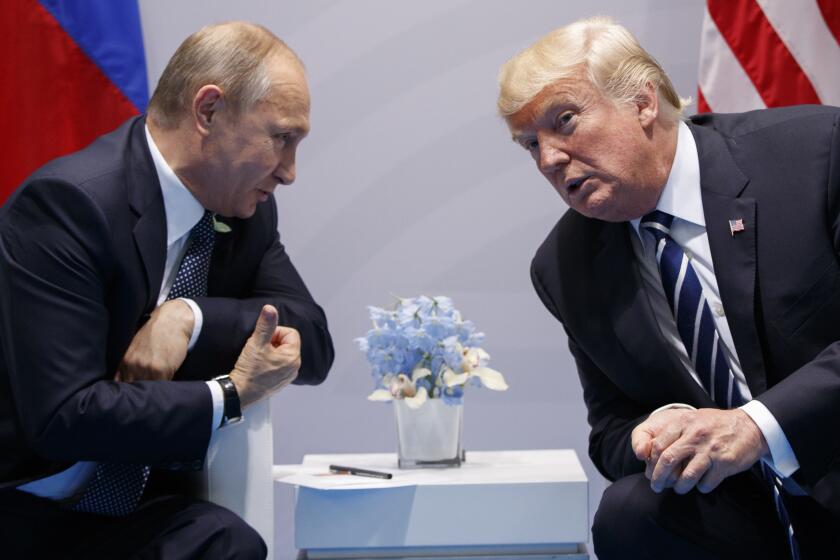Albright Bolsters Ties in Strategic Mongolia
- Share via
ULAN BATOR, Mongolia — On the surface, Mongolia seems like merely a pleasant, inconsequential little diversion for U.S. foreign policy.
Appearances are deceiving: The United States cares about this remote, scenic country in more ways than it lets on.
When Secretary of State Madeleine Albright touched down here Saturday to pursue Washington’s avid 1990s courtship of Mongolia, there were happy photo opportunities galore. State Department officials were delighted to foster in the media the story line that the United States views Mongolia primarily as a new democracy, a curiosity and a future tourist attraction.
“This is definitely a feel-good stop,” a senior Clinton administration official helpfully informed reporters as Albright’s plane neared the Mongolian capital.
During six hours here, Albright repeatedly lavished praise on what she called Mongolia’s democratic values. However, the U.S. government’s fascination with Mongolia over the past decade is based on much more than nomads, mare’s milk and democracy.
In fact, Washington’s defense and intelligence bureaucracies have a considerable interest in Mongolia, though it is one they do not like to talk about.
Mongolia possesses one of the world’s most strategic locations. Its vast plains and steppes are nestled in between China and Russia. For the U.S., Mongolia is valuable as a possible listening post from which to monitor these two powerful countries’ activities, including missile tests or, in the past, nuclear tests.
Former Assistant Secretary of State Winston Lord once hinted at Mongolia’s underlying strategic importance to the United States in an appearance before Congress.
Mongolia “has been helpful to us [the United States] in some international issues, including arms control,” said Lord in 1995 testimony to the Senate Appropriations Committee. He called Mongolia “a relatively small country sandwiched between two giants.”
For most of the 20th century, Mongolia existed under the domination of the Soviet Union. The Soviets stationed troops here. During the height of the Sino-Soviet feud of the 1960s and 1970s, China feared the Soviet troops in Mongolia might someday be used as the advance guard for a Soviet invasion of China.
Under Chinese pressure, the Soviet Union began pulling its troops out of Mongolia in the late 1980s. Since then, as the Soviet influence gradually declined and Mongolia dismantled its Communist system, the U.S. has come knocking ever more insistently on Mongolia’s door.
In the 19th century, Britain and Russia used to play what was called the Great Game, competing for influence throughout Central Asia. In Mongolia, the United States seems to be playing at least a little game, showing both Russia and China that Washington has a friendly country in their neighborhood.
Albright’s visit Saturday marked the third occasion that an American secretary of State has taken the time and effort to come here.
Secretary of State James A. Baker III made the first trip in 1990, suggesting that his main interest was in looking at Mongolia’s rare breeds of ibex and argali sheep.
As it happened, that trip took place on the day Iraq invaded Kuwait, and Baker left hurriedly. But Baker’s purported interest in Mongolian sheep was so great that he returned again the following year for a three-day visit.
On that second trip, U.S. and Mongolian officials quietly concluded a science agreement that was signed in the presence of American military and defense officials.
Since then, the United States has set up a $400,000 program to train Mongolian military leaders. American officials are helping the Mongolian armed forces with communications and with disaster preparation.
The United States has also established a sizable Peace Corps presence here and has given Mongolia about $80 million in economic aid over the last five years.
Meanwhile, American dignitaries have been streaming to Mongolia, keeping the goodwill of the country’s leadership. First Lady Hillary Rodham Clinton stopped by in 1995.
There was reportedly some discussion earlier this year of having President Clinton visit Mongolia after his trip to China in late June, but Chinese officials have made clear that they do not want Clinton to visit any other Asian country.
During Albright’s visit Saturday, she signed a new joint statement with the Mongolian government, pledging “continuing U.S. support for Mongolia’s fledging democracy.”
“They love us,” a senior State Department official said of the Mongolians. “This is not surprising, if you look at the map.”
More to Read
Sign up for Essential California
The most important California stories and recommendations in your inbox every morning.
You may occasionally receive promotional content from the Los Angeles Times.










